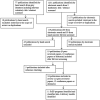A review of HIV pre-exposure prophylaxis (PrEP) programmes by delivery models in the Asia-Pacific through the healthcare accessibility framework
- PMID: 32603517
- PMCID: PMC7326464
- DOI: 10.1002/jia2.25531
A review of HIV pre-exposure prophylaxis (PrEP) programmes by delivery models in the Asia-Pacific through the healthcare accessibility framework
Abstract
Introduction: In the Asia-Pacific, pre-exposure prophylaxis (PrEP) is a newly introduced public health intervention for minimizing HIV transmission, the coverage of which has remained limited. The best delivery models and strategies for broadening access of the vulnerable communities are not fully known. This review identified PrEP programmes reported in the Asia-Pacific, which were classified by delivery models and assessed with a healthcare accessibility framework.
Methods: We performed a literature search on PubMed and Ovid MEDLINE using relevant search terms, manual searched grey literature by visiting relevant websites, examined reference lists and contacted authors for clarification of included PrEP programmes reported through July 2019. A structured table was used for data extraction and summarizing findings in accordance with the five constructs of approachability, acceptability, availability, affordability and appropriateness grounded in the conceptual framework of Healthcare Accessibility.
Results and discussion: This literature search yielded a total of 1308 publications; 119 full texts and abstracts were screened, and 24 publications were included in the review. We identified 11 programmes implemented in seven cities/countries in the Asia-Pacific. A typology of four PrEP delivery models was delineated: (a) fee-based public service model; (b) fee-based community setting model; (c) free public service model; and (d) free community setting model. Overall, the free community setting model was most commonly adopted in the Asia-Pacific, with the strength to boost the capacity of facility and human resources, which enhanced "approachability", "availability" and "acceptability." The free public service model was characterized by components designed in improving "approachability," "availability" and "appropriateness," with attention on equity in accessing PrEP. Among free-based models, long-term affordability both to the government and PrEP users would need to be maximized to increase accessibility. Alongside the need for raising awareness, supportive environments and ensuring timely access were means for enabling the development of a sustainable PrEP service.
Conclusion: PrEP programmes could be classified by delivery models through the five constructs of healthcare accessibility. While the coverage of PrEP remains limited in the Asia-Pacific, an evaluation of these models could benchmark best practices, which would in turn allow effective models to be designed.
Keywords: Asia-Pacific; HIV prevention; accessibility; delivery model; implementation; pre-exposure prophylaxis.
© 2020 The Authors. Journal of the International AIDS Society published by John Wiley & Sons Ltd on behalf of International AIDS Society.
Figures
References
-
- McCormack S, Dunn DT, Desai M, Dolling DI, Gafos M, Gilson R, et al. Pre‐exposure prophylaxis to prevent the acquisition of HIV‐1 infection (PROUD): effectiveness results from the pilot phase of a pragmatic open‐label randomised trial. Lancet. 2016;387(10013):53–60. 10.1016/S0140-6736(15)00056-2. PMID: 26364263. - DOI - PMC - PubMed
-
- World Health Organization (WHO). Policy brief: WHO expands recommendation on oral pre‐exposure prophylaxis of HIV infection (PrEP). November 2015. [cited 2019 Nov 1]. Available from: https://apps.who.int/iris/bitstream/handle/10665/197906/WHO_HIV_2015.48_....
Publication types
MeSH terms
Substances
LinkOut - more resources
Full Text Sources
Medical
Miscellaneous




